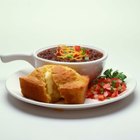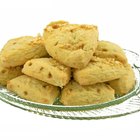
Sweet, moist and delicious, banana bread makes a fine use of overripe bananas. Banana bread is classified as a quick bread, which means it can be made quickly without a lot of fuss. Most quick breads rely on chemical leaveners, such as baking soda and baking powder, to make a light bread. Yeast, a fungus, is used in yeast breads, rather than quick breads. The two are not interchangeable.
Desired Texture
Quick breads, such as banana bread, have a moist, delicate texture, while yeast breads have a light, chewy texture. Yeast breads are kneaded for several minutes to develop the gluten in the flour, which is what causes the chewy texture. Gluten development produces a tough, dry quick bread, though. Yeast bread doughs are fairly thick and malleable, while quick bread doughs are thin and resemble cake batter. Because of these differences, yeast should not be used in banana bread, or any other quick bread.
Prep Methods
Even the preparation methods for yeast breads and quick breads differ. Banana bread takes less than ten minutes to mix from start to finish. Typical recipes call for creaming butter and sugar together before adding the remaining ingredients. Once the flour is added to the butter and sugar, the dough must be stirred carefully to avoid toughening it. Bread recipes that call for yeast as a leavener must be kneaded and allowed to raise, usually at least twice. From start to finish, making yeast bread can take three to 12 hours or more.
Purpose
Baking soda is an alkaline substance. When it reacts with moisture and an acidic substance, such as buttermilk, yogurt or brown sugar, it creates carbon dioxide bubbles, which causes the baked goods to rise. If you remember the baking soda and vinegar science experiments from elementary school, you can imagine its effect in baked goods. Whenever possible, use baking soda if it's called for in a recipe.
Alternatives
The only practical substitution for baking soda is baking powder, which is baking soda combined with cornstarch and cream of tartar. The cream of tartar provides the acid that initiates the formation of carbon dioxide bubbles so the batter rises. To substitute baking powder for baking soda, add 1 1/2 teaspoons for each cup of flour you use. Substituting baking powder results in a slight chemical taste and a finer texture than using baking soda, but in a pinch it works.
Related Articles

Can Fast Acting Yeast Be Used in Place ...

Can You Substitute Yogurt for Milk in ...
How to Make Homemade Bread

What to Do With Pizza Dough When You're ...

How Long Does Banana Bread Stay Fresh?

What Kind of Oil Do You Use in Brownie ...

How Many Calories in Gluten-Free Bread?

A List of Leavening Agents
How to Make Bread That Does Not Crumble ...

How to Make Cornbread in a Cast-Iron ...
Does Cake Flour Contain Baking Soda & ...

How to Add Gluten to All-Purpose Flour
What Is Rusk Bread?

Can You Make Dumplings With Corn Starch?

Why Use Baking Powder in Pancake Batter?

How to Make Bread Chewy

Can I Make Doughnuts From Frozen Yeast ...

What Is the Difference Between Scones & ...

How to Dissolve Xanthan Gum

How to Make Toasted Bread Sticks With ...
References
- Essentials of Baking; Williams-Sonoma
- King Arthur Flour: Quick Bread Primer
- Bon Appetit: Baking Soda
Writer Bio
Julie Christensen is a food writer, caterer, and mom-chef. She's the creator of MarmaladeMom.org, dedicated to family fun and delicious food, and released a book titled "More Than Pot Roast: Fast, Fresh Slow Cooker Recipes."
Photo Credits
Jupiterimages/Comstock/Getty Images